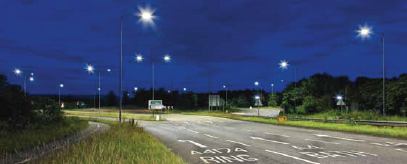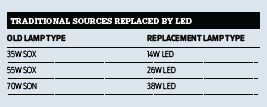Published: 8 July 2014
Category: Technical Articles
As the trend to use LED sources for streetlighting gathers pace, Dave Tilley asks whether LED streetlighting can deliver all the benefits it promises - and weighs up some of the alternatives

Gloomy streets and town centres. Orange streetlights and bland environments. Then white light and beautification
projects. There was a time before LEDs when intelligent control gear and light sources with a colour-rendering index greater than 70 per cent ensured energy efficiency and a pleasantly illuminated space.
Today, however, as the trend towards LED sources for streetlighting gathers pace, will LED streetlighting deliver the benefits its proponents claim?
The usual arguments
While the usual arguments rage about energy saving and maintenance efficiency, there are other factors that have a significant impact on the economics and appearance of our streets and town centres.
- The current trend towards turning streetlighting off in low-use or low-risk areas, however defined.
- The maintenance regime that supports luminaires that are sold on the basis that they have operating lives of five years or more.
- The management of the transition from traditional light sources to LEDs.
Turning off streetlighting is a topic that triggers passionate debate among residents and lighting professionals. Local authorities will argue that the policy increases efficiency and reduces light pollution, but residents and lighting professionals will highlight safety and the visual impact.
A key benefit of LED technology is its ability to be dimmed easily, so it is a balanced, efficient solution for local authorities that does not isolate local communities. However, the areas that local authorities target for ‘switch-offs’ are generally areas that are at the bottom of a list for streetlight upgrades.
Maintaining streetlighting in rural areas is more expensive than it is in town centres and for main roads, in the main because of transport costs and the smaller number of streetlights that can be serviced in a particular period.
Perhaps it is time to promote a more holistic approach to streetlighting.
The maintenance regime is an interesting aspect of LED streetlighting. Driving around the UK I have noticed a number of LED schemes in which one or two LED lanterns are either on all the time or have failed.
To date I have not seen any repairs to these schemes and I suspect I will not in future. Changing an LED lantern is not the same as changing a lamp, and ironically, the local authority will probably have removed the scheme from any traditional lighting
maintenance regime.
The transition to LEDs is often done scheme by scheme. However, the benefits and challenges of LED streetlighting are broader than the simple energy-saving calculations would suggest. The table below shows a few examples in which traditional light sources in residential roads and pedestrian areas have been replaced by LED (thanks to Thorn Lighting for the information):

Based on 4,000 annual operating hours, an electricity cost of $0.20 (¤0.15) per kilowatt-hour and gear losses, the savings can be estimated:

Although there is a financial benefit associated with energy efficiency, most of the savings are the result of reduced maintenance. Clearly the financial savings attributed to lower energy consumption will not provide a sensible return on investment (ROI). Bearing in mind the potential overall efficiencies that follow the installation of LED streetlights, what will be the future for lighting controls? If the ROI justifies the installation of LEDs, will the figures stack up for intelligent controls? Or will the low wattages, reduced operating costs and ability to introduce simple sensors obviate the need for more sophisticated control?
An LED lantern has individual optics that make specific and managed distribution of light possible. New lighting schemes will ensure local authorities get the full benefits of efficiency and good optical design; but point-for-point replacement schemes will have to rely on energy and maintenance efficiency. If local authorities accept the arguments of efficiency and beautification of the environment, are LEDs the only light sources that will deliver?
The simple answer is no.
Induction lighting is a clear alternative to LEDs, particularly in the commercial and industrial sectors. It has an estimated life of 65,000 hours, L70, with a failure rate of less than five per cent. Cost comparison are quite complex because numerous LED street lanterns are being promoted by a broad range of manufacturers. This continues to be a major problem in the lighting industry. Even those manufacturers that would generally be trusted to provide genuine and accurate information have been found wanting.
Having examined a range of LED and induction street lantern prices, I would have to conclude there is little difference. The key, as always, is application and lighting design.
THE LIGHTING ECONOMIST’S VERDICT LEDs are an excellent light source for streetlighting applications; but not the only one. There will be applications where induction lighting is an acceptable alternative. It is important that local authorities and other agencies remember that any light source can fail, so maintenance is still necessary to ensure failed lanterns are managed.
The relatively high investment, based on performance and quality, must be supported by a managed warranty process that supports replacement without compromising lighting quality.
The traditional approach to streetlighting management, the focus on main roads and town centres, intelligent controls and visual impact, must be reviewed to ensure budgets are being invested effectively.
Register for your free copy of Lux Review magzine at www.luxreview.com
